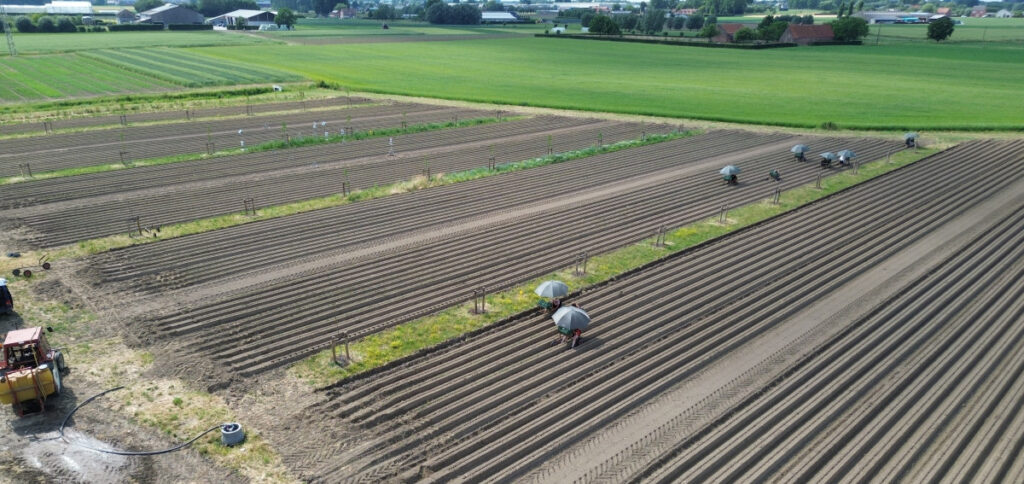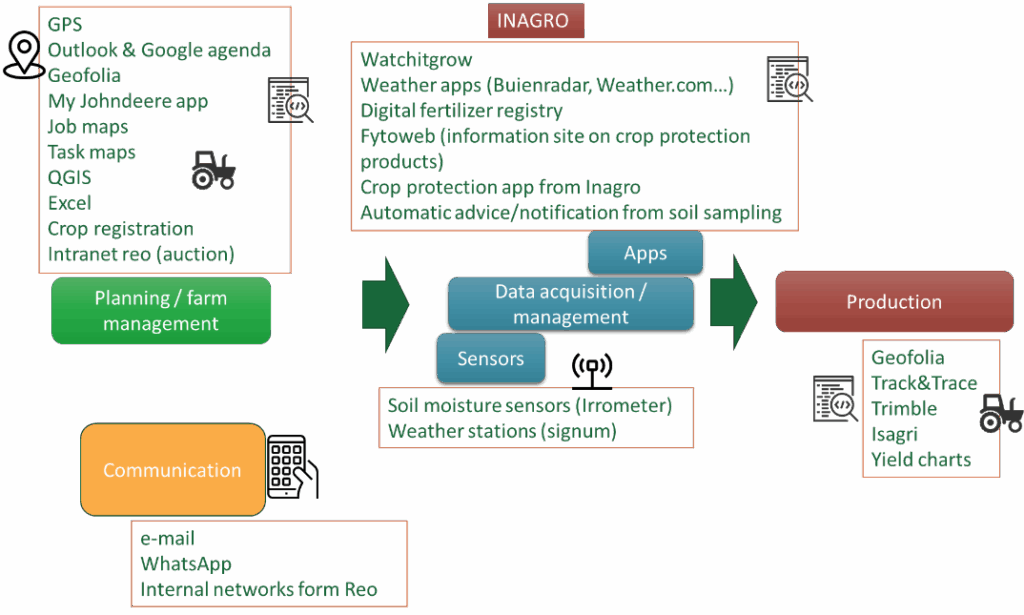Blending Agroforestry and Digital Innovation in Flanders

Local context / Issue:
INAGRO targets the deployment of an agroforestry system within the Flemish context, focussing on vegetable production between trees for the fresh product market and the industry. An agroforestry platform gives to INAGRO the opportunity to investigate technologies that can support local farmers in their venture within the agroforestry domain.
This experimental Agroforestry estate fits into a wider setup of INAGRO’s future farm-platform (Nature based Agriculture, Optifarm and Agroforestry).
Showcase Outlook
Brussels may be the scenario of new farmer’s demonstrations again, sooner than we think. 2024 ended with the European agri-food sector taking the streets of the Belgian capital protesting against the consequences of a possible EU-Mercosur agreement. A deal that can threaten even more the delicate situation of the farmers all over the continent.
Although the situation in Flanders is not as severe as in other regions, its more than 20.000 farms must take an eye on their competitiveness in the uncertain times agri-food sector is living. Not only because the possible arrival of new South American food products, but also to preserve an industry with a contribution of around the 0.9% of the region’s gross value added.
In this context, the EU’s common agricultural policy for Flanders encourages local farmers to advance towards more sustainable models where “income security, the reduction of greenhouse gas emissions, climate change adaptation, improving water quantity and quality, and productive and resilient soils” are the main objectives.
Despite a limited number of Flemish farmers adopting agroforestry, numerous projects are exploring more environmentally friendly farming methods. Agroforestry is seen as one of the possible answers to the growing demand for sustainable agricultural practices, with various initiatives supporting farmers in making bold decisions in the short and mid-term.
However, the adoption of digital tools presents some setbacks and complications. One of the main ones is, precisely, the lack of affinity between older farmers and digital tools. Participants in the local workshop expressed their frustration with available tools and Apps as these increase workloads rather than streamline them.
Beyond this will for changing and progressing, there is one concern that lies in Flanders as much as the other showcases: farm viability. Doubts about valuing supply chain for agroforestry products were raised among farmers as they requested to develop more simple and more collaborative platforms.
Because, at last, beyond possible future and more competitive market, Flanders is facing the same challenge than the other European regions: to respect traditional practices while fostering sustainable innovation.
Showcase at a glance
Showcase representative name: INAGRO, a research & advice Centre in agriculture and horticulture.
Challenge of the showcase: “How to develop an agroforestry system in the Flemish context?”
Type of production: Arable, vegetable and animal production, with an interest in agroforestry.
Type of agroecology: Mainly agroecological, some conventional.
Participants: 14 participants, mainly farmers (from very small to very large farms), but also advisors and researchers.
Showcase representative: Willem Van Colen – willem.vancolen(at)inagro.be
Location: Roeselare, West-Flanders (Belgium).
Website: https://INAGRO.be/research-and-demonstration-plot-agroforestry

Testimonials
- Podcast with the showcase ambassador :
Mapping of digital tools used in INAGRO’s showcase

A diversity of tools is used in the showcase, covering most of the range of existing digital technologies and supporting a diversity of operations on the farm. The picture illustrates the main tools for the main processes on the farm. More details about the tools are available in the Digital Tools section (link)
Usability/applicability of DTs: Main drivers, barriers, risks and trends

Drivers: #time saving #natural resource savingThe keywords for the drivers on the use of digital tools are “Boosting efficiency” in every sense of the word and reducing workload. The group also precise the role of DTs to save on resources: avoid double fertilisation & double spraying.

Barriers: #ROI & cost #data security #complexityThe biggest barriers for not using digital tools and technologies are the costs, privacy and non-user-friendliness of the platforms.

Risks: #data security #dependencyThe stronger risks were privacy, data loss and dependency.

Looking to the future/trends: #sensors #DSS #integrated data platform Interests were high in exploring new DTs for spot spraying, crop registration, forecasting diseases and pests, robotics, soil scan & soil moist sensors & irrigation watch.
The added value of the used digital tools and technologies
When grouped according to specific management activities, digital tools and technologies become key enablers of the agroecological transition. Their combined use supports more resilient and sustainable farming practices. Explore how digital tools and technologies enhance this showcase management—step through the timeline of its core activities.
More details about the tools are available in the Digital Tools section (link).
Agroforestry production: vegetables between trees
What do farmers from this showcase expect as improvement or new function for digital tools to enhance their transition to more agroecological practices?
The GAP analysis was performed individually to give participants the opportunity to highlight the problems they encountered. Also because of the value it adds to get a better Idea of shortcomings with the agroforestry seen in Flanders, because of agroforestry still being in its infancy in Flanders. There was discussion between the participants on the problems they encountered. There was a lot of input from the participants. One thing did stand out and that was that tools like google agenda or outlook did not immediately arise for the participants. Which points to the fact that some tools are so ingrained in daily use that we don’t even think about them anymore. In the beginning, the participants first thought about the more complicated tools such as notion, watch it grow, excel. Tools that they do not use every day but are indispensable in the operation of the company. The aspect that came back most often was ease of use and easy downloading of information from the tools. The older generation that was participating in the workshop showed a lower affinity with digital tools than the younger generation. With was to be expected. For some, working comfort supported by DTs was a good point, for others, tools were too complicated and may cause extra work. They express their wish for user-friendly tools, integrated tools.
Because of the infancy of agroforestry in Flanders the Gap Analysis on the supply chain was also conducted individually. This was an interesting exercise to see what the farmers were looking for but also the other players in the supply chain. Here the main conclusion was that the farmers know where to go with the products coming from conventional agriculture but are searching for other channels to place their products coming from agroforestry. In this the efforts that are being made to develop an agroforestry map where farmers and buyers can find each other is crucial. There is a wish expressed for a better connection between farmers and buyers in creating new supply chains.
They emphasise the idea that digitalisation will not lead to prioritising agroecology, that it comes from a “mindset”. They can be keen on digitalising their farms although reluctant to agroecology with a fear of lower profits. If in this showcase the generation gap towards digitalisation was clear, they all agreed that they would rather be in the field than behind the screens.
More details on the gaps found in the 6 showcases can be explored in the Gap Analysis section (link).

